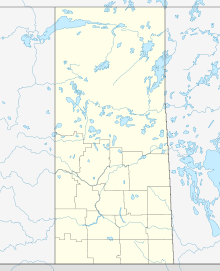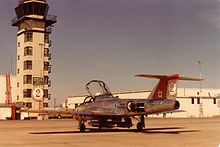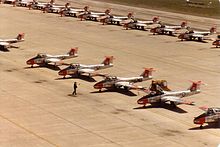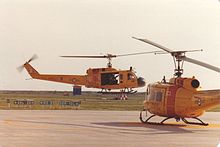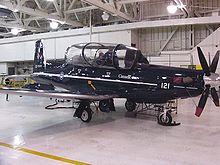- CFB Moose Jaw
-
CFB Moose Jaw
Moose Jaw/Air Vice Marshal C.M. McEwen AirportIATA: YMJ – ICAO: CYMJ
– WMO: 71864Summary Airport type Military Owner Government of Canada Operator DND Location Moose Jaw No. 161, Saskatchewan Elevation AMSL 1,892 ft / 577 m Coordinates 50°19′49″N 105°33′33″W / 50.33028°N 105.55917°WCoordinates: 50°19′49″N 105°33′33″W / 50.33028°N 105.55917°W Map Location in Saskatchewan Runways Direction Length Surface ft m 03/21 3,400 1,036 Asphalt 11L/29R 8,326 2,538 Asphalt 11R/29L 7,280 2,219 Asphalt Source: Canada Flight Supplement[1]
Environment Canada[2]Canadian Forces Base Moose Jaw (IATA: YMJ, ICAO: CYMJ), commonly referred to as 15 Wing Moose Jaw and CFB Moose Jaw, is a Canadian Forces Base located 4 NM (7.4 km; 4.6 mi) south of Moose Jaw, Saskatchewan. It is operated as an air force base by the Royal Canadian Air Force and is home to flight training conducted by the Canadian Forces.
The base's airfield is named after Air Vice-Marshal Clifford McEwen and is one of only three military aerodromes in Canada to be named after an individual; Valcartier (W/C J.H.L. (Joe) Lecomte) Heliport and Cold Lake/Group Captain R.W. McNair Airport being the others.
CFB Moose Jaw's airfield is also used by civilian aircraft, with civilian operations at the base referring to the facility as Moose Jaw/Air Vice Marshal C.M. McEwen Airport.
The airport is classified as an airport of entry by NAV CANADA and is staffed by the Canada Border Services Agency. The customs service is currently restricted to 15 Wing - Moose Jaw aircraft only.[1]
Contents
Base history
A civilian flying club aerodrome was established on the site south-southwest of Moose Jaw in 1928 by the Moose Jaw Flying Club. Its location surrounded by flat open prairie proved to be an ideal training site.
RCAF Station Moose Jaw
The declaration of World War II saw the Moose Jaw Flying Club initially contracted to provide pilot training for the Royal Canadian Air Force, however this was soon replaced by the far larger British Commonwealth Air Training Plan (BCATP) which saw the Government of Canada acquire the aerodrome and completely reconstruct it into RCAF Station Moose Jaw in 1940 with the new aerodrome opening in 1941.
Initially the Royal Air Force trained exclusively at the base under the RAF's No. 32 Service Flying Training School (SFTS) (ca. 1942) using Harvards, and later, Oxfords. No. 32 SFTS eventually broadened its intake to train 1,200 pilots for the air forces of Canada, the United Kingdom, Norway, New Zealand, Poland, France, Czechoslovakia, Belgium, the United States and the Netherlands.
In 1946 RCAF Station Moose Jaw was decommissioned and the aerodrome was returned to civilian service after the war.
Rising Cold War tensions saw the aerodrome reactivated by the RCAF in 1953 as the site of military pilot training. RCAF Station Moose Jaw undertook additional construction to support its expanded personnel complement. The base was used by the RCAF and its NATO allies for pilot training, using both single-prop World War II-era Harvards and CT-133 Silver Star jet training aircraft. By the mid-1960s these were both replaced by the Canadian built CT-114 Tutor.
The Institute for stained glass in Canada has documented the stained glass at RCAF Base Chapel.[3]
CFB Moose Jaw
In 1968 the RCAF merged with the Canadian Army and the Royal Canadian Navy to form the unified Canadian Forces. The base's name was changed to Canadian Forces Base Moose Jaw, usually shortened to CFB Moose Jaw. From 1968 until the formation of Air Command in 1975, CFB Moose Jaw fell under the direction of Training Command and served to house the Tutor Jet Training Program.
By the early 1990s, CFB Moose Jaw was operated by over 1,300 employees and made a significant economical impact on the region, but pending cutbacks in military spending spread rumours of possible closure of the base. In 1994 Bombardier Inc. put forth a proposal to provide what is now the NATO Flying Training in Canada program. The proposal was accepted and eliminated all worries that the base would be closed. Many of the base's structures were renovated to accommodate new personnel and new training aircraft. Pilots from Denmark, Singapore, Great Britain, Italy, Hungary, Germany, Finland and many other allied nations train at CFB Moose Jaw every year, ensuring the base's future with the Canadian Forces.
From 1970 until its disbandment in 1993 Moose Jaw had a Base Rescue Flight flying three CH-118 Huey helicopters.[4]
During a reorganization at AIRCOM in the late 1990s, CFB Moose Jaw's various AIRCOM units were placed under a new primary lodger unit called "15 Wing"; consequently the base is frequently referred to as 15 Wing Moose Jaw.
Current operations
Base Rescue Moose Jaw CH-118 Iroquois helicopters at CFB Moose Jaw, 1982
CFB Moose Jaw is home to the following units:
- 2 Canadian Forces Flying Training School
- NATO Flying Training in Canada program
- 15 Wing Moose Jaw
The base is one of only two Canadian Forces facilities in Saskatchewan, the other being CFAD Dundurn, a detachment of 17 Wing, Winnipeg.
15 Wing annually holds an Armed Forces Day with flight demonstrations by the Snowbirds and foreign air force aircraft, as well as ground displays by Army and Navy Reserve units in the surrounding area.[citation needed]
References
Raytheon CT156 Harvard II at CFB Moose Jaw, 3 November 2005
- ^ a b Canada Flight Supplement. Effective 0901Z 20 October 2011 to 0901Z 15 December 2011
- ^ Synoptic/Metstat Station Information
- ^ Stained glass at RCAF Base Chapel
- ^ AEROWARE / RCAF.com (2010). "Bell CH-118 IROQUOIS". http://www.rcaf.com/Aircraft/aircraftDetail.php?IROQUOIS-168. Retrieved 4 October 2010.
- ^ Canadian Forces (July 2009). "15 Wing". http://www.airforce.forces.gc.ca/15w-15e/units-unites/page-eng.asp?id=636. Retrieved 2009-07-18.
External links
- 15 Wing - Moose Jaw
- NATO Flying Training in Canada
- Canadian Air Force Snowbirds Demonstration Team
- Moose Jaw Flying Club
- Encyclopedia of Saskatchewan
- Past three hours METARs, SPECI and current TAFs for CFB Moose Jaw from NAV CANADA as available.
Airports in Canada By name A–B · C–D · E–G · H–K · L–M · N–Q · R–S · T–ZBy location indicator CA · CB · CC · CD · CE · CF · CG · CH · CI · CJ · CK · CL · CM · CN · CO · CP · CR · CS · CT · CV · CW · CY · CZBy province/territory National Airports System Calgary · Charlottetown · Edmonton · Fredericton · Gander · Halifax · Iqaluit · Kelowna · London · Moncton · Montréal-Mirabel · Montréal-Trudeau · Ottawa · Prince George · Québec · Regina · Saint John · St. John's · Saskatoon · Thunder Bay · Toronto · Vancouver · Victoria · Whitehorse · Winnipeg · YellowknifeRelated List of airports by ICAO code: C · List of defunct airports in Canada · List of heliports in Canada · List of international airports in Canada · National Airports System · Operation Yellow Ribbon Royal Canadian Air Force
Royal Canadian Air Force 
Chief of the Air Staff · Installations · List of aircraft
History: Canadian Aviation Corps (1914-1915) · Canadian Air Force (1918-1920) · Canadian Air Force (1920-1924) · Royal Canadian Air Force (1924-present)
Snowbirds · List of Wings 1 Wing Kingston · 3 Wing Bagotville · 4 Wing Cold Lake · 5 Wing Goose Bay · 8 Wing Trenton · 9 Wing Gander · 12 Wing Shearwater · 14 Wing Greenwood
15 Wing Moose Jaw · 16 Wing Borden · 17 Wing Winnipeg · 19 Wing Comox · 22 Wing North Bay - List of Squadrons
Training: Canadian Forces School of Aerospace Technology and Engineering

 Canadian Forces bases and stations
Canadian Forces bases and stationsCurrent CFB Borden · CFB Edmonton · CFB Gagetown · CFB Kingston · CFB Montreal · CFB Petawawa · CFB Shilo · CFB St. Hubert · CFB Suffield · CFB Valcartier · CFB Wainwright · LFAATC Aldershot · LFCATC MeafordCFB Bagotville · CFB Borden · CFB Comox · CFB Cold Lake · CFB Gander · CFB Goose Bay · CFB Greenwood · CFB Kingston · CFB Moose Jaw · CFB North Bay · CFB Trenton · CFD Mountain View · CFB WinnipegAll servicesDND Headquarters · CFS Alert · CFS Leitrim · CFNA HQ Whitehorse · CFNA HQ Yellowknife · Camp Nathan Smith · ASU Saint-JeanDefunct BasesCFB Calgary · CFB Baden-Soellingen · CFB Chatham · CFB Chilliwack ASU Chilliwack · CFB Clinton · CFB Cornwallis · CFB Downsview Denison Armoury · CFB Griesbach · CFB Lahr · CFB London · CFB Moncton · CFB Ottawa · CFB Penhold • CFB Picton · CFB Portage la Prairie · CFB Rivers · CFB Rockcliffe · CFB Shearwater · CFB St. Jean · CFB Summerside · CFB Toronto · CFB Uplands · CFB WinnipegStationsCFS Aldergrove · CFS Alsask · CFS Armstrong · CFS Baldy Hughes · CFS Barrington · CFS Beausejour · CFS Beaverlodge · CFS Bermuda · CFS Carp · CFS Chibougamau · CFS Churchill · CFS Cobourg · CFS Coverdale · CFS Dana · CFS Debert · CFS Falconbridge · CFS Flin Flon · CFS Foymount · CFS Frobisher Bay · CFS Gloucester · CFS Gypsumville · CFS Holberg · CFS Kamloops · CFS Ladner · CFS Lac St. Denis · CFS Lowther · CFS Masset · CFS Mill Cove · CFS Moisie · CFS Mont Apica · CFS Moosonee · CFS Newport Corner · CFS Ramore · CFS Senneterre · CFS Shelburne · CFS Sioux Lookout · CFS Sydney · CFS Val-d'Or · CFS Whitehorse · CFS YorktonTemporary basesCanada Dry One • Canada Dry Two • Camp Julien • Camp MirageCategories:- Canadian Forces bases in Saskatchewan
- Royal Canadian Air Force stations
- Airports of the British Commonwealth Air Training Plan
- Airports in Saskatchewan
- Buildings and structures in Moose Jaw
- Moose Jaw No. 161, Saskatchewan
- Transportation in Moose Jaw
Wikimedia Foundation. 2010.

